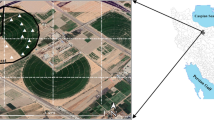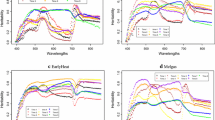Abstract
Biomass can indicate plant growth status, so it is an important index for plant growth monitoring. This paper focused on the methodology of estimating the winter wheat biomass based on hyperspectral field data, including the LANDSAT TM and EOS MODIS images. In order to develop the method of retrieving the wheat biomass from remote sensed data, routine field measurements were initiated during periods when the LANDSAT satellite passed over the study region. In the course of the experiment, five LANDSAT TM images were acquired respectively at early erecting stage, jointing stage, earring stage, flowering stage and grain-filling stage of the winter wheat, and the wheat biomass was measured at each stage. Based on the TM and MODIS images, spectral indices such as NDVI, RDVI, EVI, MSAVI, SIPI and NDWI were calculated. At the same time, the hyperspectral field data was used to compute the normalized difference in spectral indices, red-edge parameters, spectral absorption, and reflection feature parameters. Then the correlation coefficients between the wheat biomass and spectral parameters of the experiment sites were computed. According to the correlation coefficients, the optimal spectral parameters for estimating the wheat biomass were determined. The bestfitting method was employed to build the relationship models between the wheat biomass and the optimal spectral parameters. Finally, the models were used to estimate the wheat biomass based on the TM and MODIS data. The maximum RMSE of estimated biomass was 66.403 g/m2.
Similar content being viewed by others
References
Bao Y S (2006). Research of monitoring winter wheat growth using multi-source remote sensing data. Dissertation. Beijing: Bejing Normal University (in Chinese)
Baret F, Jacquemoud S, Guyot G, Leprieur C (1992). Modeled analysis of the biophysical nature of spectral shifts and comparison with information content of broad bands. Remote Sensing of Environment, 41(2–3): 133–142
Bonham-Carter G F (1988). Numerical procedures and computer program for fitting an inverted-Gaussian model to vegetation reflectance data. Computers and Geosciences, 14: 339–356
Buschmann C, Nagel E (1993). In vivo spectroscopy and internal optics of leaves as basis for remote sensing of vegetation. International Journal of Remote Sensing, 14: 711–722
Cho M A, Skidmore A K, Atzberger C (2008). Towards red-edge positions less sensitive to canopy biophysical parameters for leaf chlorophyll estimation using properties optique spectrales des feuilles (PROSPECT) and scattering by arbitrarily inclined leaves (SAILH) simulated data. International Journal of Remote Sensing, 29(8): 2241–2255
Clevers J G P W, De Jong S M, Epema G F, Van Der Meer F D, Bakker W H, Skidmore A K, Scholte K H (2002). Derivation of the red edge index using the MERIS standard band setting. International Journal of Remote Sensing, 23(16): 3169–3184
Collins W, Raines G L, Canney F C (1977, November 7–9). Airborne spectroradiometer discrimination of vegetation anomalies over sulphide mineralisation-a remote sensing technique. In: Abstract with Programmes. Seattle, Washington: Geological Society of America, 932–933
Colombo R, Meroni M, Marchesi A, Busetto L, Rossini M, Giardino C, Panigada C (2008). Estimation of leaf and canopy water content in poplar plantations by means of hyperspectral indices and inverse modeling. Remote Sensing of Environment, 112(4): 1820–1834
Curran P J (1989). Remote sensing of foliar chemistry. Remote Sensing of Environment, 30: 271–278
Curran P J, Windham W R, Gholz H L (1995). Exploring the relationship between reflectance red edge and chlorophyll concentration in slash pine leaves. Tree Physiology, 15: 203–206
Dawson T P, Curran P J (1998). A new technique for interpolating red edge position. International Journal of Remote Sensing, 19: 2133–2139
Del Frate F, Wang L F (2001). Sunflower biomass estimation using a scattering model and a neural network algorithm. International journal of remote sensing, 22(7): 1235–1244
Gao B C (1996). NDWI-a normalized difference water index for remote sensing of vegetation liquid water from space. Remote Sens Environ, 58: 257–266
Gates D M, Keegan H J, Schleter J C, Weidner V R (1965). Spectral properties of plants. Applied Optics, 4(1): 11–20
Ge S K, Xu M, Anderson G L, Carruthers R I (2007). Estimating Yellow Starthistle (Centaurea solstitialis) leaf area index and aboveground biomass with the use of hyperspectral data. Weed Scince,55(6): 671–678
Gitelson A A, Vina A, Arkebauer T J, Rundquist D C, Keydan G, Leavitt B (2003). Remote estimation of leaf area index and green leaf biomass in maize canopies. Geophysical Research Letters, 30(5): 1248, doi:10.1029/2002GL016450, 52-1-52-4
Horler D N H, Dockray M, Barber J (1983). The red edge of plant leaf reflectance. International Journal of Remote Sensing, 4: 273–288
Huang W J, Wang J H, Wang Z J, Jiang Z C, Liu L Y, Wang J D (2004). Inversion of foliar biochemical parameters at various physiological stages and grain quality indicators of winter wheat with canopy reflectance. International Journal of Remote Sensing, 25(12): 2409–2419
Huete A R, Liu H Q, Batchily K, van Leeuwen W (1997). A comparison of vegetation indices over a global set of TM images for EOSMODIS, Remote Sensing of Environment 59: 440–451
Jensen A, Lorenzen B, Spelling-Ostergaard H, Kloster-Hvelplund E (1990). Radiometric estimation of biomass and N content of barley grown at different N levels. International Journal of Remote Sensing,11: 1809–1820
Jin Y Q, Liu C (1997). Biomass retrieval from high-dimensional active/passive remote sensing data by using artificial neural networks. International journal of remote sensing, 18(4): 971–979
van Keulen H, Goudriaan J, Seligman N G (1989). Modelling the effects of nitrogen canopy development and crop growth. In: Russell G, Marshall B, Jarvis P G, eds. Plant Canopies: Their Growth Form and Function. Cambridge: Cambridge University Press, 83–104
Liu LY (2002). Hyperspectral Remote Sensing Application in Precision Agriculture. Postdoctoral Report, 42–45
Liu LY, Wang J H, Huang W J, Zhao C J, Zhang B (2004). Estimating winter wheat plant water content using red edge parameters. International Journal of Remote Sensing, 25(17): 3331–3342
Liu S F, Liou Y, Wang W J (2002). Retrieval of crop biomass and soil moisture from measure 1.4 and 10.65 GHz brightness temperatures. IEEE Transactions on Geoscience and Remote Sensing, 40(6): 1260–1268
Miller J R, Hare E W, WU J (1990). Quantitative characterization of vegetation red edge reflectance 1. An inverted-Gaussian reflectance model. International Journal of Remote Sensing, 11: 1755–1773
Penuelas J, Baret F, Filella I (1995). Semi-empirical indices to assess carotenoids/chlorophyll a ratio from leaf spectral reflectance. Photosynthetica 31: 221–230
Qi J, Chehbouni A, Huete A R, Keer Y H, Sorooshian S (1994). A modified soil vegetation adjusted index. Remote Sens. Environ. 48: 119–126
Railyan V Y, Korobov R M (1993). Red edge structure of canopy reflectance spectra of triticale. Remote Sensing of Environment, 46: 173–182
Rougean J L, Breon FM (1995). Estimating PAR absorbed by vegetation from bidirectional reflectance measurements. Remote Sens. Environ. 51: 375–384
Rouse J W, Haas R H, Schell J A, Deering D W, Harlan J C (1974). Monitoring the vernal advancements and retrogradation of natural vegetation. NASA/GSFC, Greenbelt, MD
Starks P J, Zhao D, Brown M A (2008). Estimation of nitrogen concentration and in vitro dry matter digestibility of herbage of warm-season grass pastures from canopy hyperspectral reflectance measurements. Grass and Forage Science, 63: 168–178
Svoray T (2002). SAR-based estimation of areal above ground biomass (AAB) of herbaceous vegetation in the semi-arid zone: a modification of the water-cloud model. International Journal of Remote Sensing, 23(19): 4089–4100
Tilling A K, O’Learyb G J, Ferwerdaa J G, Jonesa S D, Fitzgeraldb G J, Rodriguezc D, Belford R (2007). Remote sensing of nitrogen and water stress in wheat. Field Crops Research, 104(1–3): 77–85
Vuolo F, Dini L, D’Urso G (2008). Retrieval of leaf area index from CHRIS/PROBA data: an analysis of the directional and spectral information content. International Journal of Remote Sensing, 26 (17-18): 5063–5072
Wu C Y, Niu Z, Tang Q, Huang W J (2008). Estimating chlorophyll content from hyperspectral vegetation indices: modeling and validation. Agricultural and Forest Meteorology, 148(8-9): 1230–1241
Zarco-Tejada P J, Berjon A, Lopez-Lozano R, Miller J R, Martin P, Cachorro V, Gonzalez M R, De Frutos A (2005). Assessing vineyard condition with hyperspectral indices: Leaf and canopy reflectance simulation in a row-structured discontinuous canopy. Remote Sensing of Environment, 99(3): 271–287
Author information
Authors and Affiliations
Corresponding author
Rights and permissions
About this article
Cite this article
Bao, Y., Gao, W. & Gao, Z. Estimation of winter wheat biomass based on remote sensing data at various spatial and spectral resolutions. Front. Earth Sci. China 3, 118–128 (2009). https://doi.org/10.1007/s11707-009-0012-x
Received:
Accepted:
Published:
Issue Date:
DOI: https://doi.org/10.1007/s11707-009-0012-x




